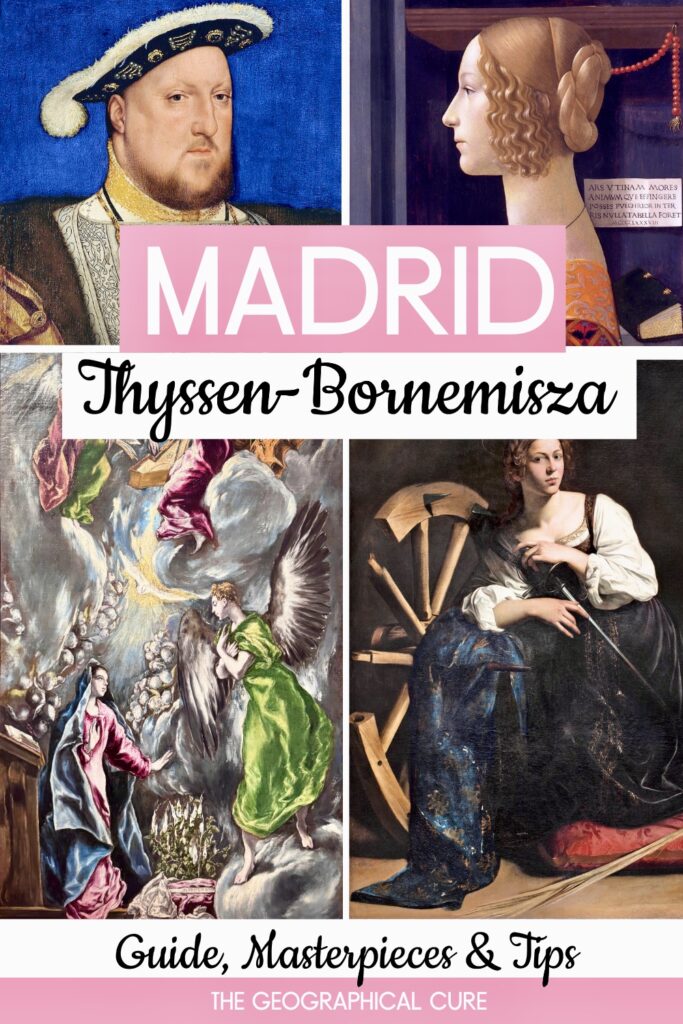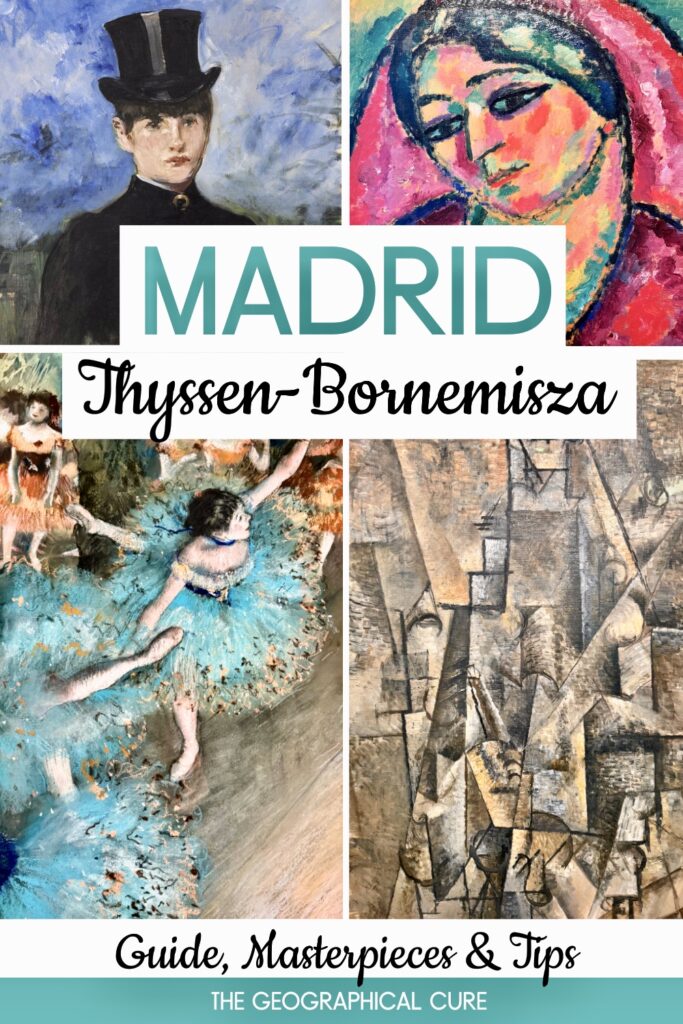I know this is a heresy, but if I could only visit one museum in Madrid, it would be the Thyssen-Bornemisza Museum.
It holds the exceptional collection of Baron Heinrich Thyssen and his son Hans — jet-setters, old money aristocrats, and billionaire industrialists. Hans once announced “I’d love to stop collecting — it costs so much money.”
Despite that (not inconsequential) obstacle, the baron impulse-shopped on a grand scale. He built the world’s largest private collection after the British Royal Collection. It combines great wealth with great taste.
Eventually, in a moment of largesse and desperate to find a proper home for his artworks, the baron sold his collection to the Spanish state in 1993. The state had renovated the Villahermosa Palace just for him.
I had thought that the museum was the place to go for Impressionism in Madrid. But that couldn’t be further from the truth!
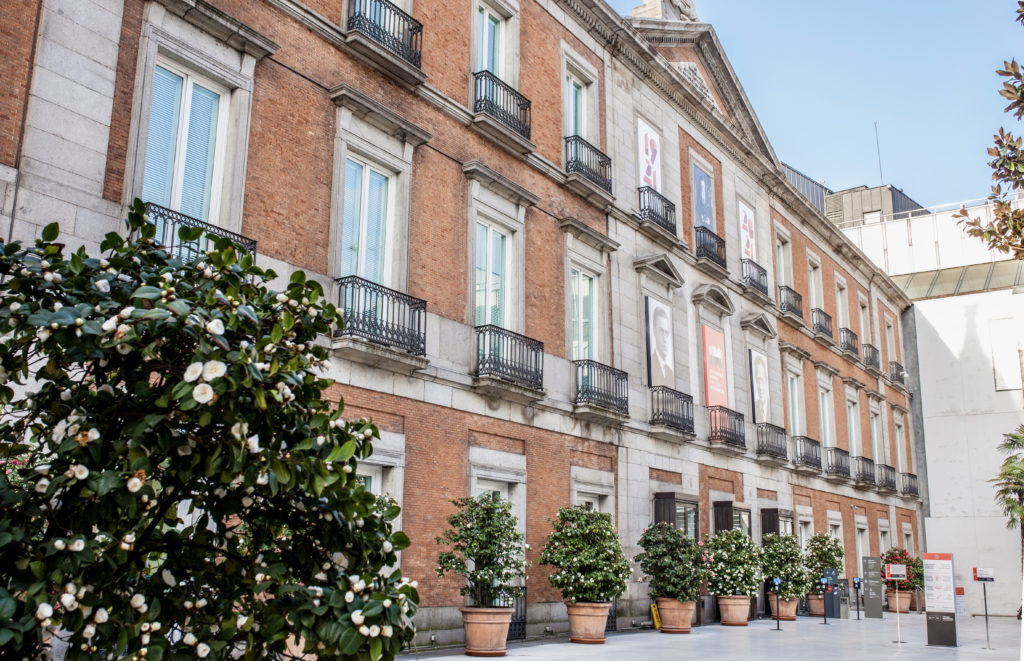
The museum displays an exceedingly well-rounded collection of the best of Western art from the last 800 years. It turns out that the first baron liked old masters and his son preferred Modernism.
As such, the Thyssen is a nice complement to the Prado, taking over where that museum leaves off. The museum even calls itself “everyone’s museum.”
The museum is divided into the Carmen Thyssen Collection on the ground floor and the Thyssen collection on the first and second floors.
I would skip the ground floor and concentrate on the upper floors. Even then, prepare to spend 2-3 hours at the museum. There’s a lot to see.
The first floor displays Modernist paintings. You can see all the “isms” of the 20th century. You’ll find works by the Surrealists, Fauves, the Blue Riders, German Expressionism, Abstract Expressionism, and Pop Art.
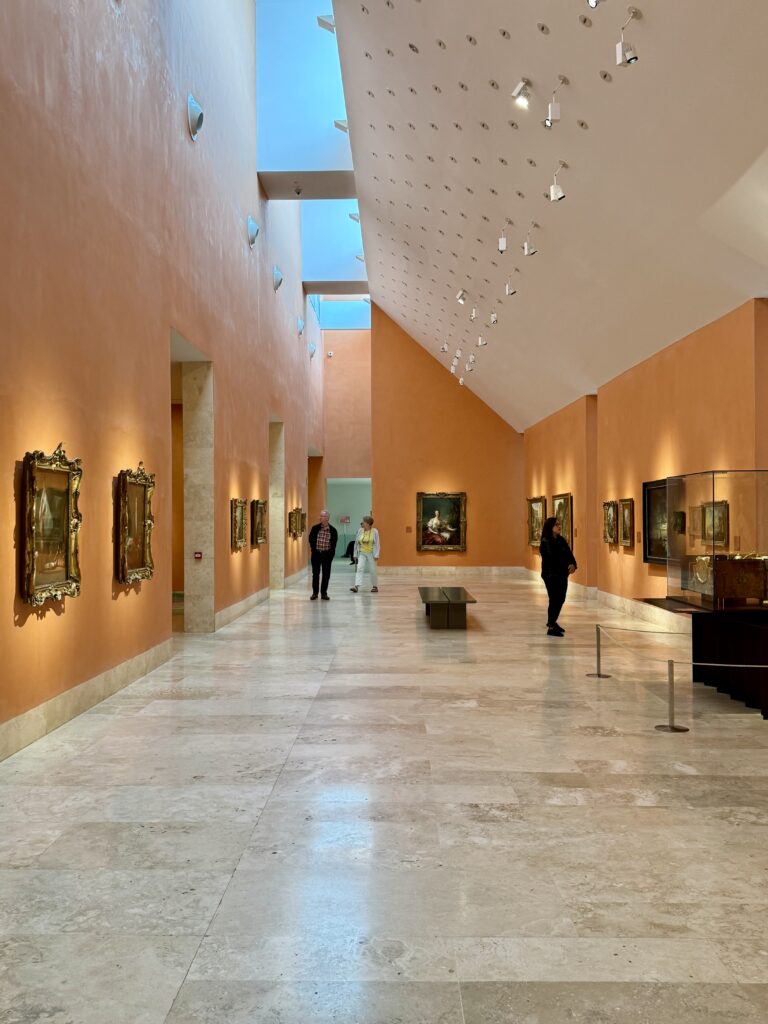
The second floor houses Old Masters from the 16th to the 19th centuries. They paintings are set against salmon colored walls, as the baroness requested (not terribly appealing visually to me).
Every great European master is represented. You’ll see artworks by early Italian Renaissance masters, Albrecht Dürer, El Greco, Canaletto, Caravaggio, Rembrandt, and Goya.
If you want to see the artworks in chronological order, head up to Room 1 on the second floor and work your way down. If you’re short on time, pick one floor to focus on. I loved the first floor best myself.
There are no flat out masterpieces. But the overall sweep of the collection is magnificent.
In this guide to the Thyssen, I identify and describe 20 of the must see masterpieces and give you tips for visiting.
>>> Click here to book a skip the line ticket and tour
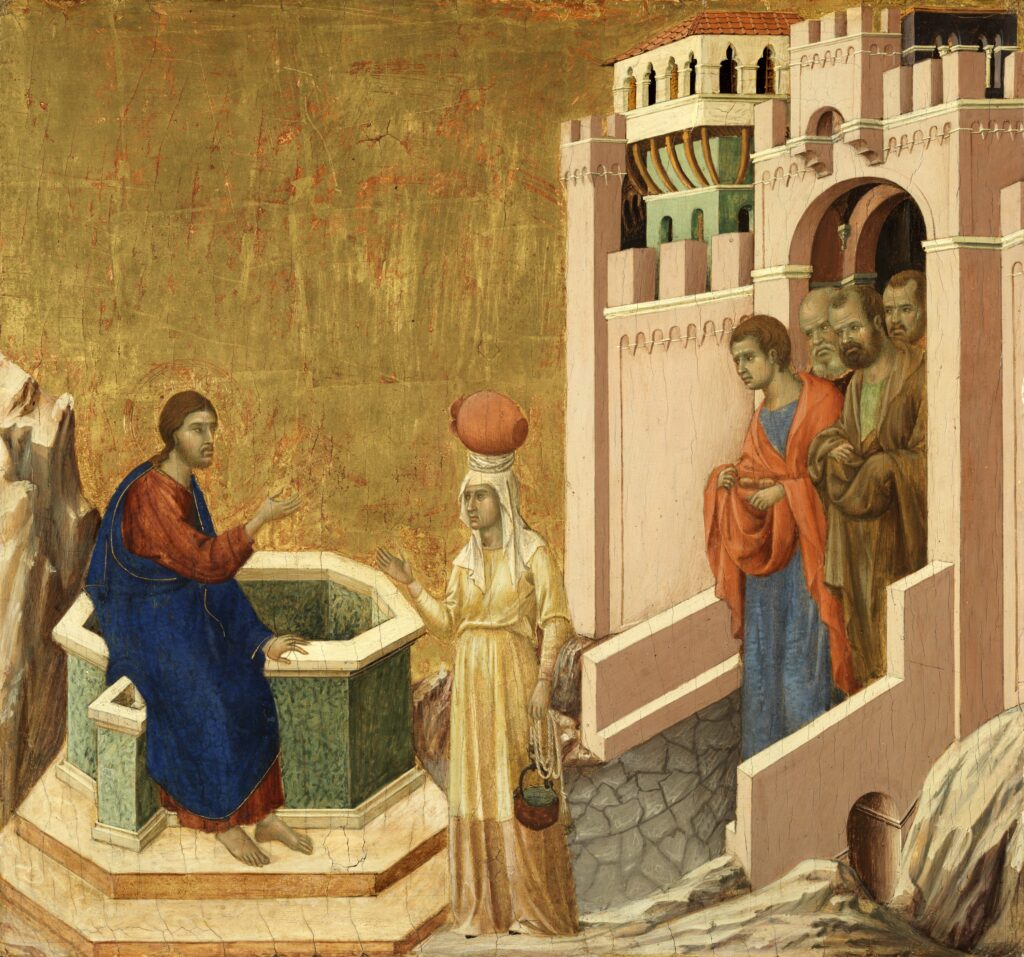
Guide To The Thyssen-Bornemisa: What To See
1. Duccio, Christ and the Samaritan Woman
Hailing from Siena, Duccio is celebrated as a trailblazer in the evolution of Western art. His work, while retaining elements of Byzantine tradition, introduced a lyrical quality and genuine emotional depth to his canvases.
His figures radiate a distinctive tenderness, offering a glimpse into artistic trends that would later come to define the High Renaissance.
This painting was part of the Maesta altarpiece for Siena Cathedral. Thyssen acquired it privately from the John D. Rockefeller II collection, a real coup.
It combines tradition and innovation. You can see the stylized Gothic style in its golden background.
But, for almost the first time in Western art, there are architectural elements, which create a realistic 3D space rather than a flat space. The figures aren’t static and their spaces express their human individualistic feelings.
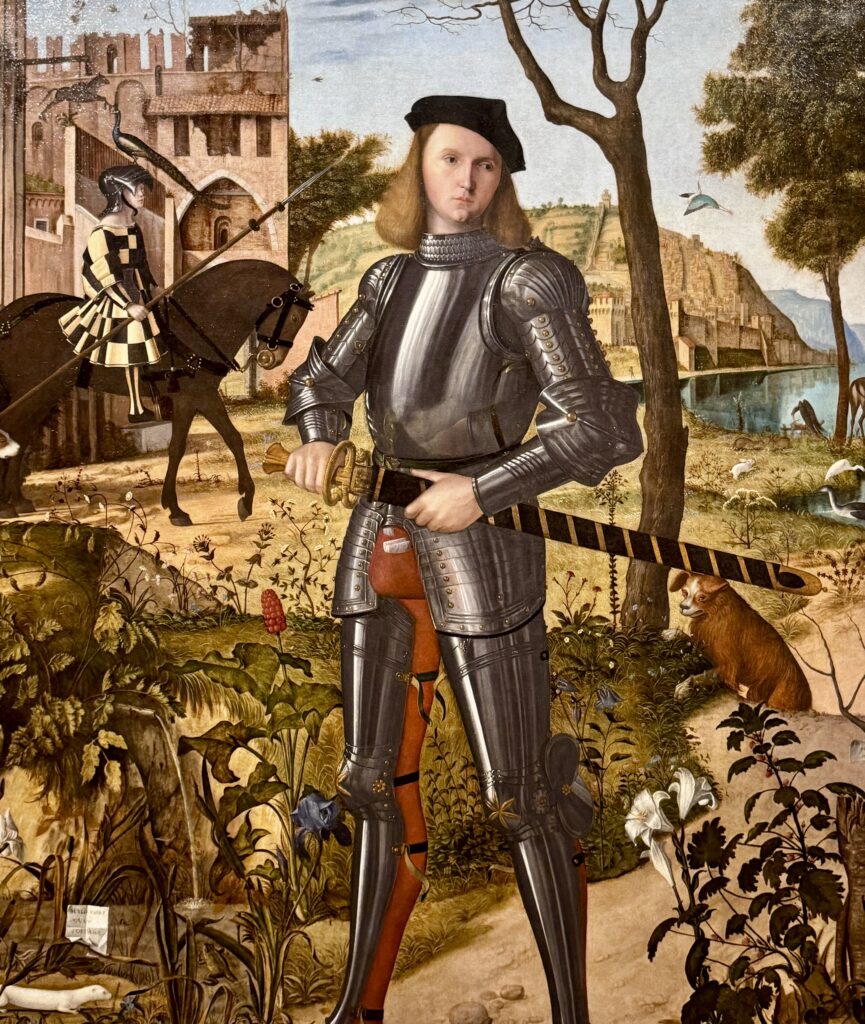
2. Carpaccio, Young Knight In A Landscape
I first saw this painting at an exhibition at the National Gallery of Art in Washington DC. I loved it and was happy to see it again.
Carpaccio is a Venetian painter who was active in the late 15th and early 16th centuries. He’s renowned for his vivid storytelling style, rich color palette, and meticulous attention to detail.
Recently restored, this painting was attributed to Dürer until 1919. In fact, Carpaccio considered it his masterpiece. The first Baron Thyssen agreed, claiming it was once of his favorite artworks in his collection.
The painting is partly naturalistic and partly stylized. The motto “death rather than dishonor” placed beside a short-tailed ermine (a symbol of purity) suggests that he’s a knight of the Order of the Ermine.
A number of hypotheses have been advanced regarding the identity of the figure. He may be the Venetian capitano Marco Gabriel or simply an idealized portrait to remember someone fallen in battle.
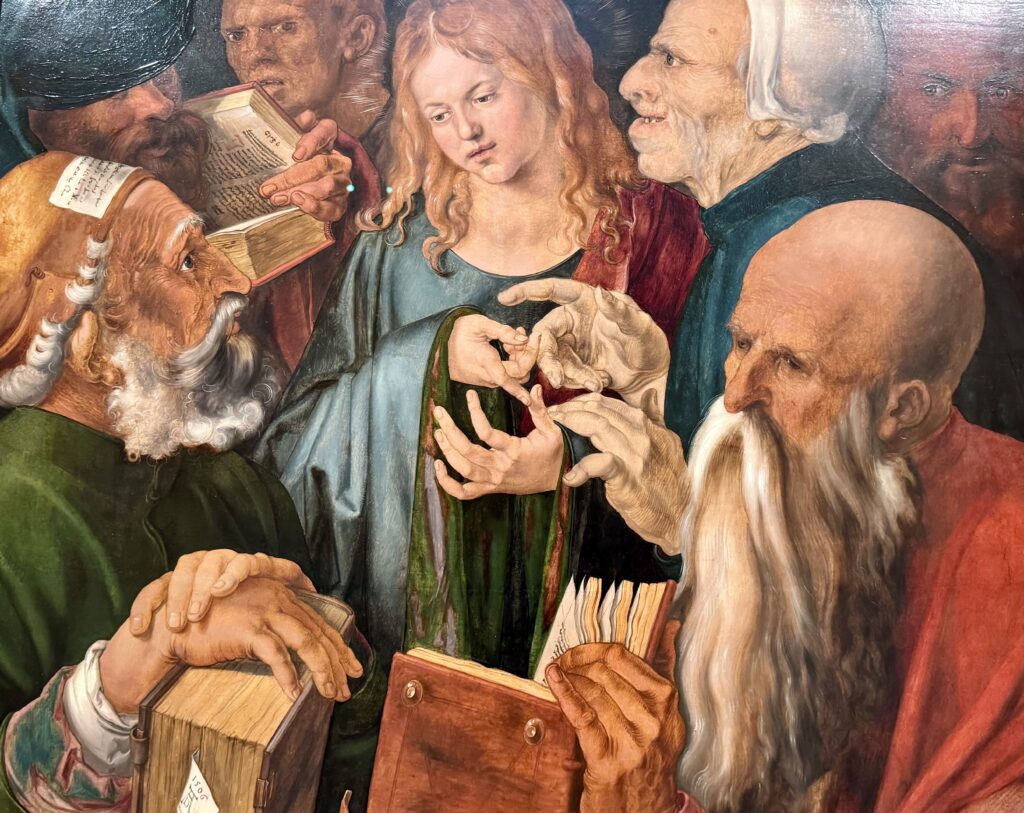
3. Albrecht Dürer, Jesus Among the Doctors
The German paintings are on display in Rooms 8 and 9. The best one of the bunch is this Dürer painting.
Dürer was a German Renaissance polymath, excelling as an accomplished painter, pioneering printmaker, and humanist thinker.
His self-portraits, groundbreaking in their era, could arguably make him a forerunner of today’s selfies.
This Dürer paintings was executed in Venice. It’s a compelling composition that draws the eye to the hands at the center, an Italian trademark.
Thus, the painting blends the two Renaissance worlds of Northern Europe and Italy.
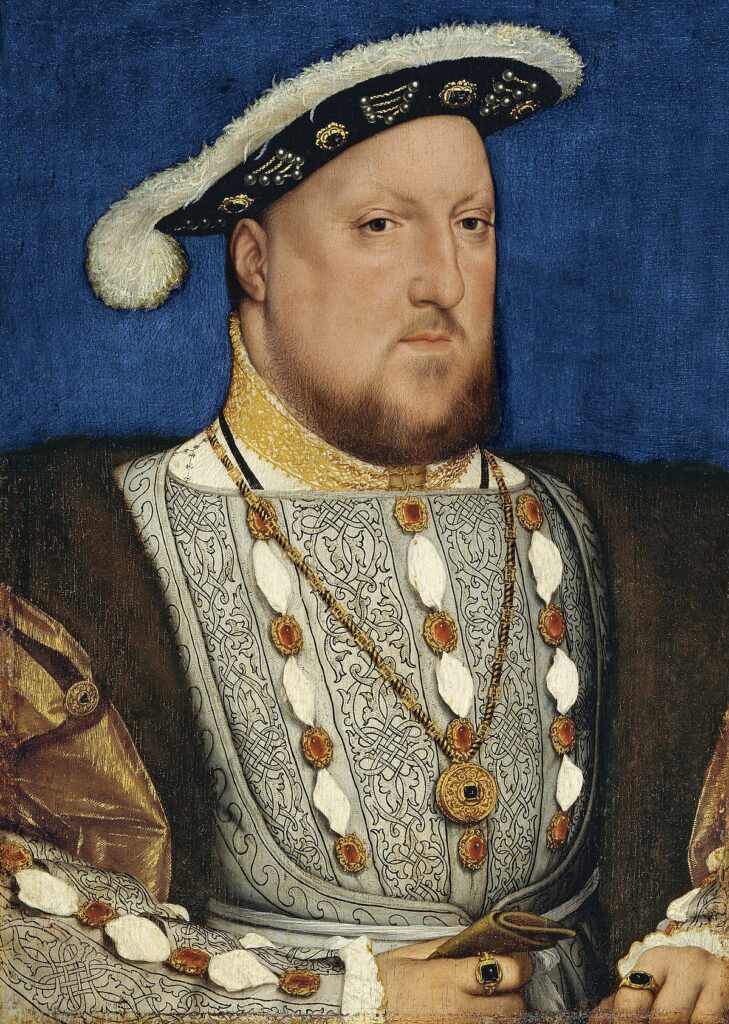
4. Hans Holbein, Portrait of Henry VIII of England
I didn’t expect to see Henry VIII at the Thyssen, but there he is in Room 5.
Hans Holbein the Younger was a German-Swiss artist renowned for his precise and detailed portraits, which are some of the most iconic images of Tudor England.
Holbein was considered “the King’s Painter.” He was in charge of executing Henry’s desire to be “not only a King to be obeyed, but an Idol to be worshipped.”
This portrait has a remarkable realism and insight. In this markedly linear image, Holbein uses a regal frontal pose and the position of his hands to convey the sitter’s powerful personality and majestic bearing
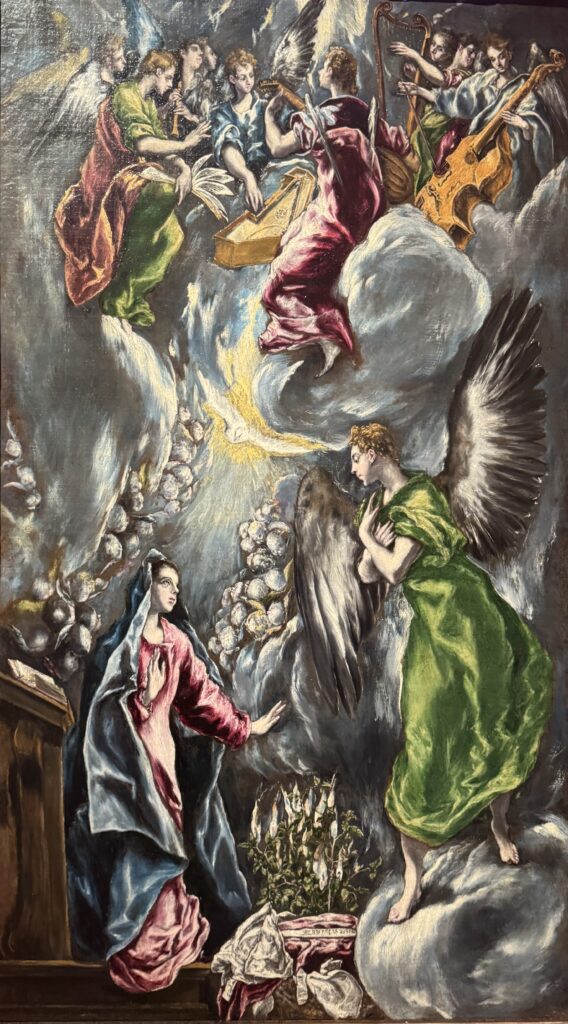
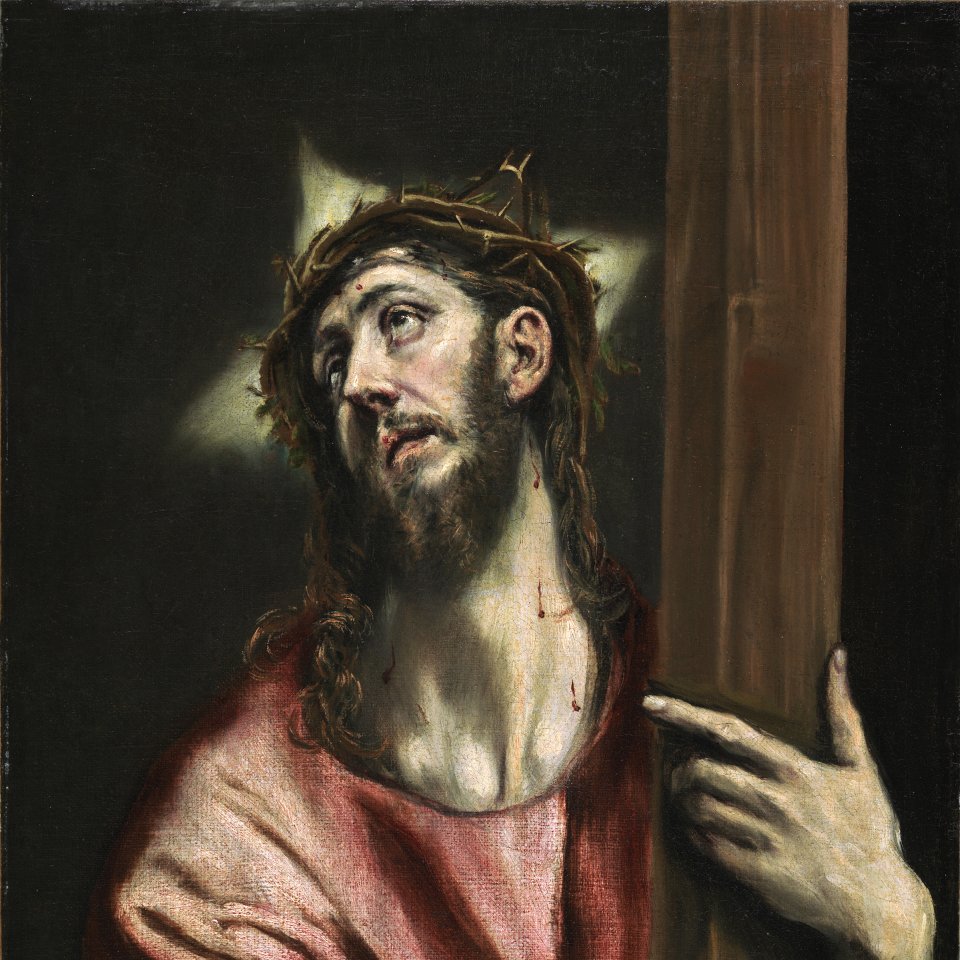
5. El Greco Paintings
In Room 11, you’ll find a few fine El Grecos. The artist was a Greek painter who made his career in Toledo. He was one of the most original artists of the 16th century.
You’ll likely recognize his work straight away. El Greco is famous for his religious paintings featuring elongated (almost deformed) figures and acidic, unreal colors.
The Annunciation is a small scale replica of the canvas on the same subject now in the Prado Museum. Still, you can see his brilliance and the freshness of the coloring.
Christ with the Cross is a portrait of a type very popular with the artist’s patrons. Christ stands alone, isolated against a dark sky. El Greco encourages the viewer to focus on his physical suffering.
READ: Guide To El Greco’s Art In Toledo
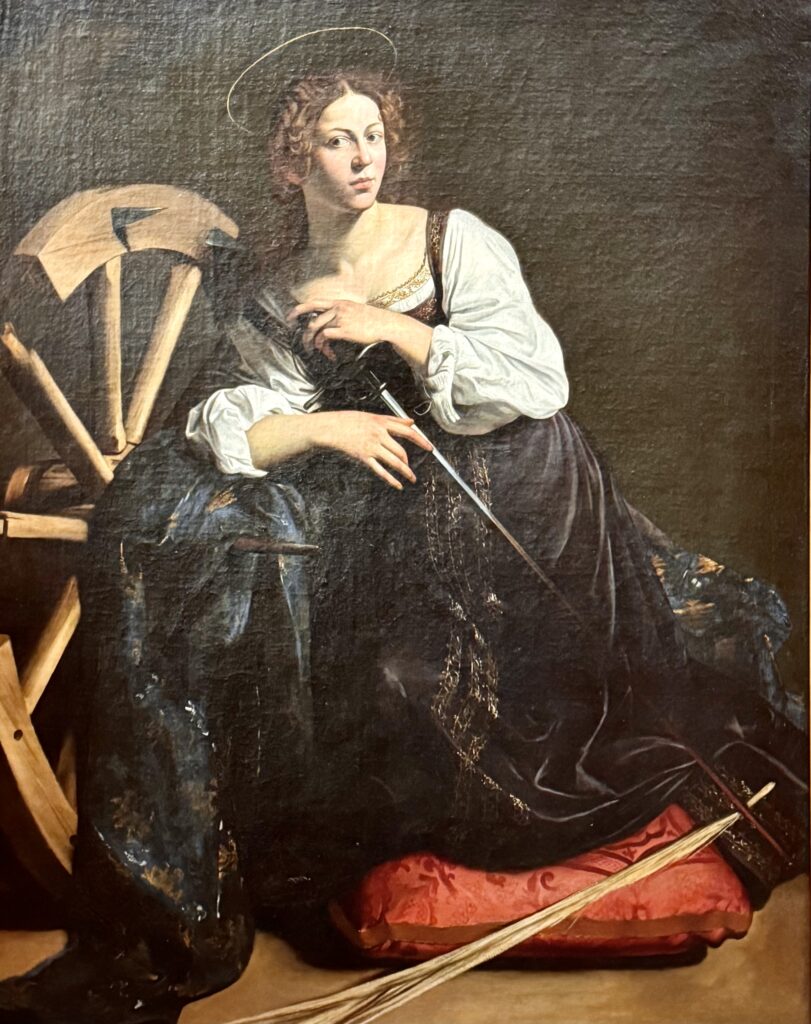
6. Caravaggio, Saint Catherine of Alexandria
There are only four Caravaggio paintings in all of Spain. The Thyssen owns one from the great Italian Baroque master, who revolutionized painting.
Cardinal Francesco Maria del Monte, Caravaggio’s earliest patron, commissioned this painting of Saint Catherine of Alexandria. She’s portrayed in a remarkably natural pose, and believed to be modeled after Fillide Melandroni, a well-known courtesan of that era.
Adorned in lavish robes that signify her royal status and kneeling on a cushion, she looks directly at the viewer. Her expression is serene yet profound.
Around her are symbols of her martyrdom: the wheel intended to break her, the sword used for her beheading, and the palm branch representing her sacrifice.
Caravaggio’s use of dramatic lighting enhances the scene, creating the intense chiaroscuro effect that is a hallmark of his work.
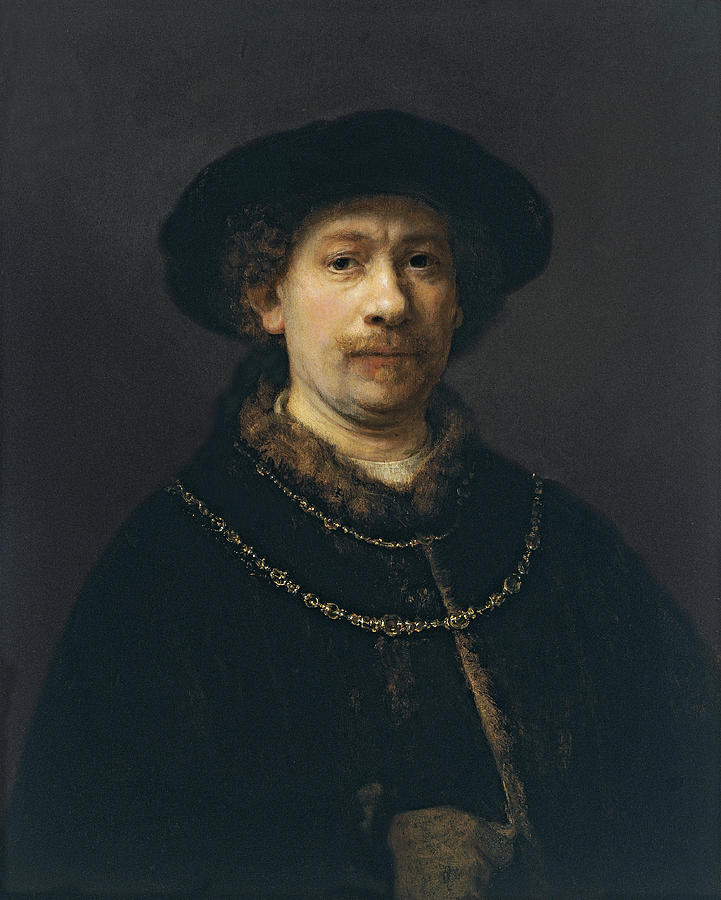
7. Rembrandt, Self-Portrait
Rembrandt van Rijn was a Dutch master and one of the greatest painters and printmakers in European art history. He’s celebrated for his profound understanding of human emotion and his innovative use of light and shadow.
Rembrandt is famous for his numerous self portraits. They give a chronicle of his physical appearance, which is unique for artists.
This one isn’t one of his finest. It’s a bit worse for wear.
Rembrandt paints himself bust-length, almost frontally, wearing dark clothes with only a hint of light in the chain. Despite the simplicity of the scene, the painting is like a mirror of his soul.
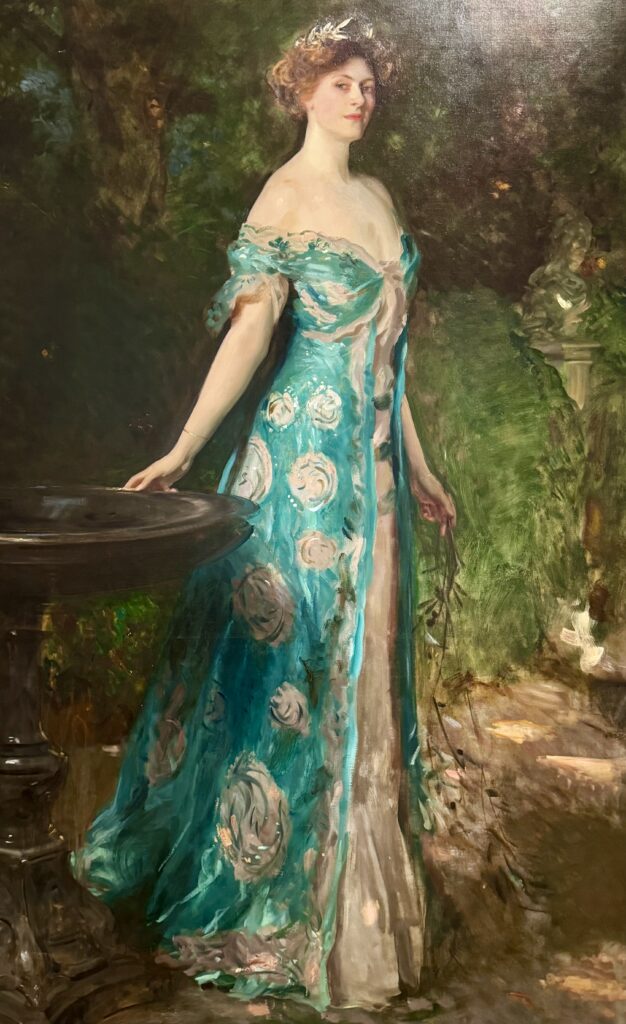
8. John Singer Sargent, Portrait of the Duchess of Sutherland
The museum’s American and English paintings aren’t all that riveting. Especially after the fine Dutch and Spanish works.
But there was a particularly appealing one, Sargent’s Portrait of the Duchess of Sutherland.
Sargent was a very cosmopolitan American expatriate artist celebrated for his boldly painted portraits of the wealthy and influential figures of his time. He captures the elegance and sophistication of the Gilded Age.
In this painting, the duchess is rendered with his signature fluid brushstrokes and masterful use of light. With one hand resting on a fountain, she wears a green, floral pattern dress seeming to emerge from the natural world itself.
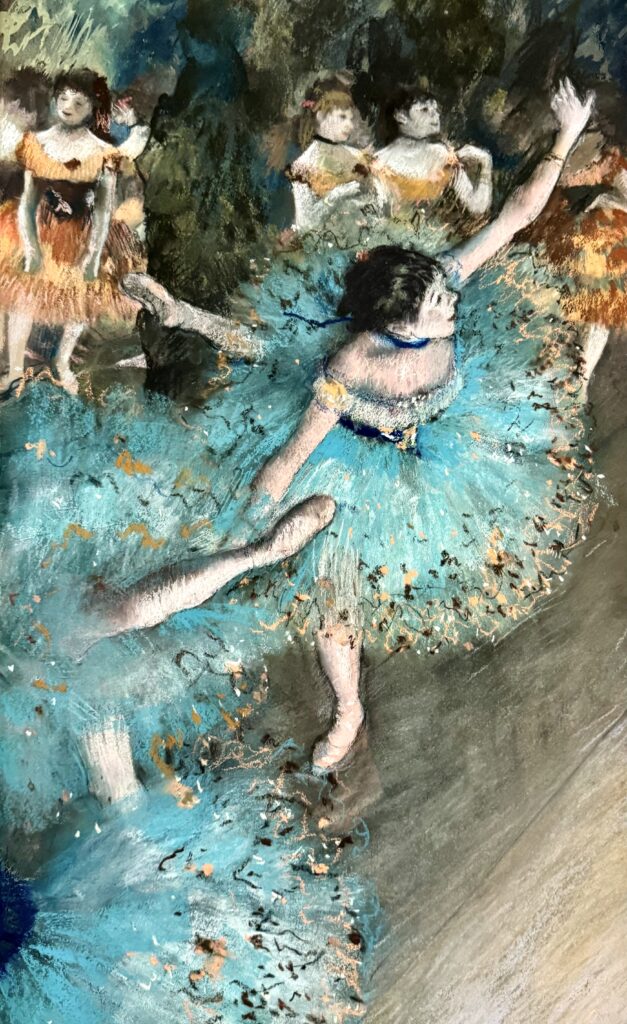
9. Edgar Degas, Swaying Dancer in Green
Edgar Degas was a French artist famous for his contributions to the Impressionist movement, though he preferred to be called a realist and painted indoors.
Best known for his captivating depictions of ballet dancers, Degas excelled in capturing moments of movement and grace, with a mastery of light and shadow.
This famous Degas painting depicts a group of dancers mid-performance, seen from the perspective of an upper side box. Among them, a dancer in green is fully depicted as she performs a quick, intricate spin.
The other dancers are partially shown, inviting viewers to imagine the full scene for themselves. In the backdrop, several ballerinas dressed in orange await their moment.
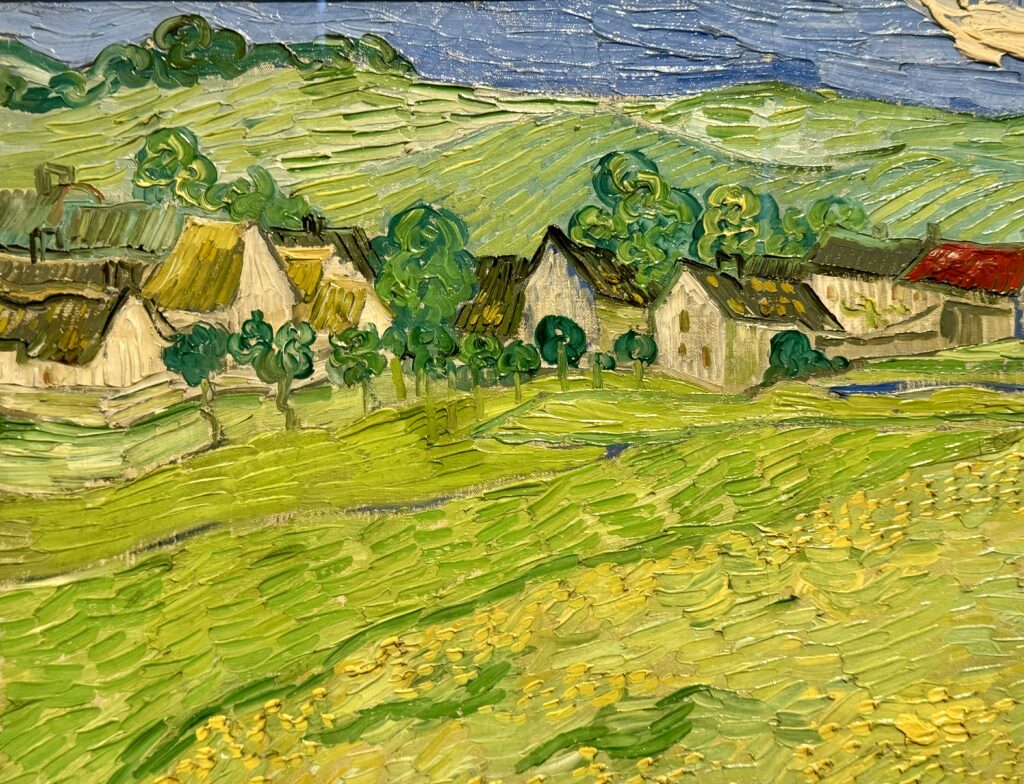
10. Van Gogh Paintings
The museum has three Van Gogh works on display. Van Gogh was a Dutch Post-Impressionism artist who spend most of his life in France painting outdoors.
His Post-Impressionist work is known for its swirling line, raw emotional honesty, and bold vivid color. His radical landscapes were like nothing anyone had painted before.
Les Vessenots was executed shortly before his death in Auvers-sur-Oise. It shows a group of thatched cottages in a high horizon and wheat fields broken up by only a few swaying trees.
It has the artist’s usual agitated brushstrokes and his favorite green and yellow colors. Although Van Gogh painted from life, his works reflect his personal vision and experience of the landscape.
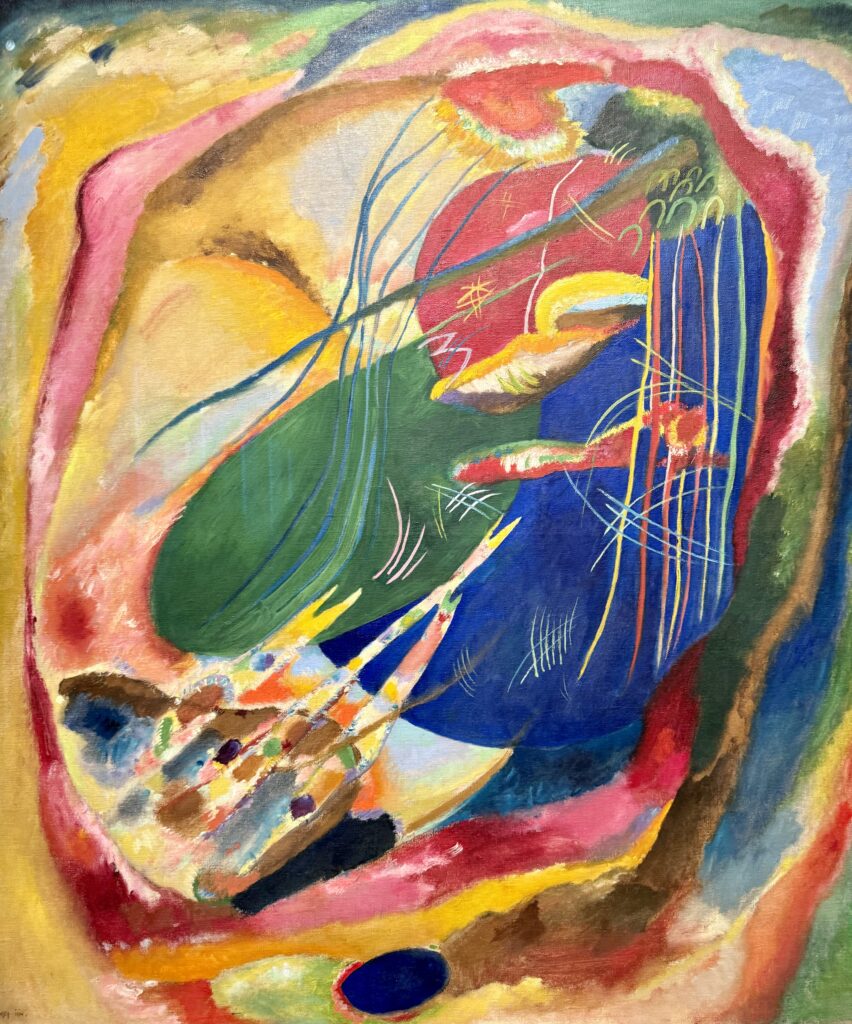
11. Kandinsky, Picture with Three Spots
Wassily Kandinsky was a pioneering Russian artist credited with creating the first purely abstract works in modern art. His goal was to portray “the outward expression of an inner content.”
Through his bold use of color and innovative compositions, Kandinsky sought to evoke emotional responses, believing that art could visually express musical compositions and stir the soul.
In Three Spots, three large oval spots at the center of the composition are surrounded by swirling shapes and bright colors. The artist stresses the religious symbolism of the number three and his personal universe of spiritual, mystical aspirations.
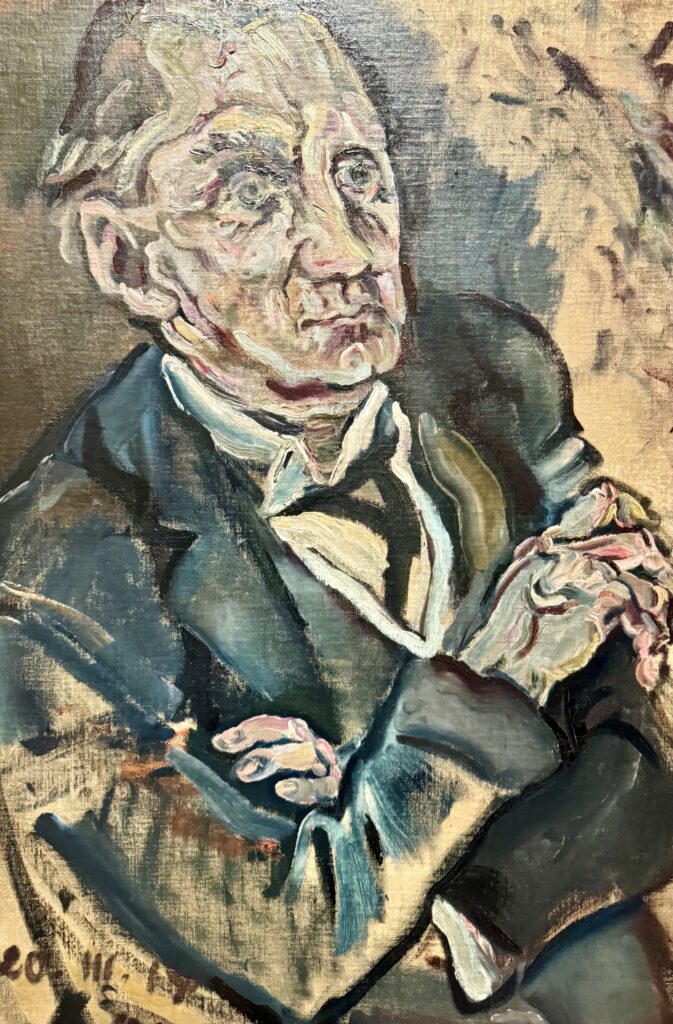
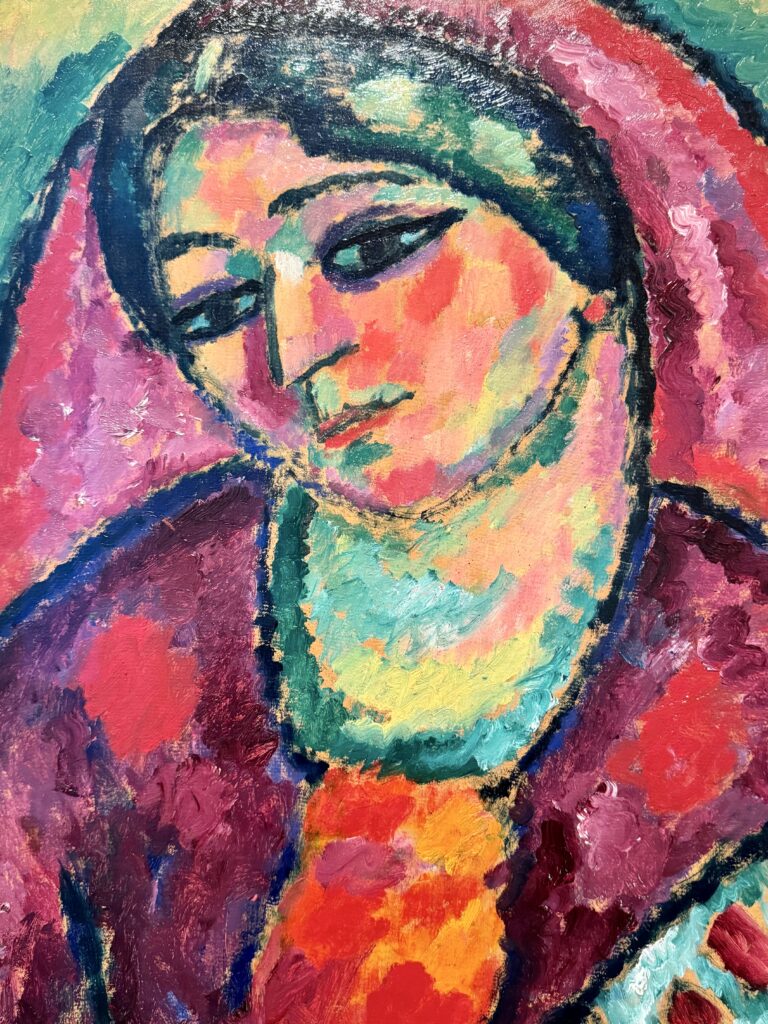
12. German Expressionist Paintings
The Thyssen has a superlative collection of the German Expressionists in Rooms 35-40. It’s almost akin to visiting the Leopold Museum in Vienna.
The German Expressionists were a group of avant-garde artists in the early 20th century. They sought to convey raw emotion and the anxieties of modern life through bold colors, distorted forms, and dramatic compositions.
The museum has works by Munch, Kokoschka, Molde, Schiele, Jawlensky, and Kirchner. The portraits are excellent.
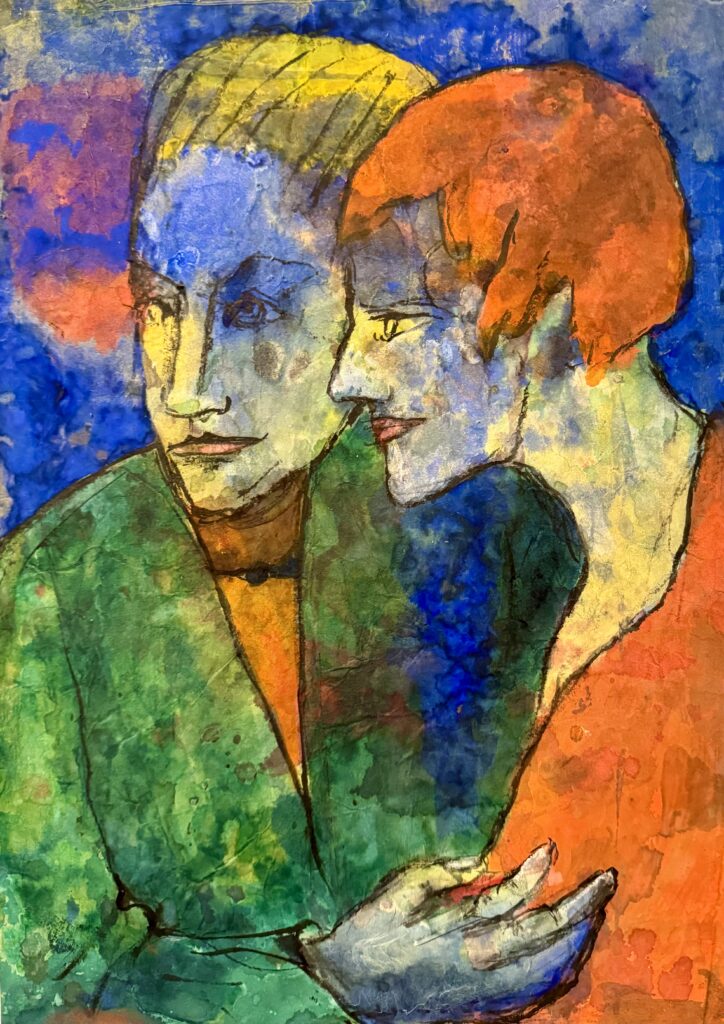
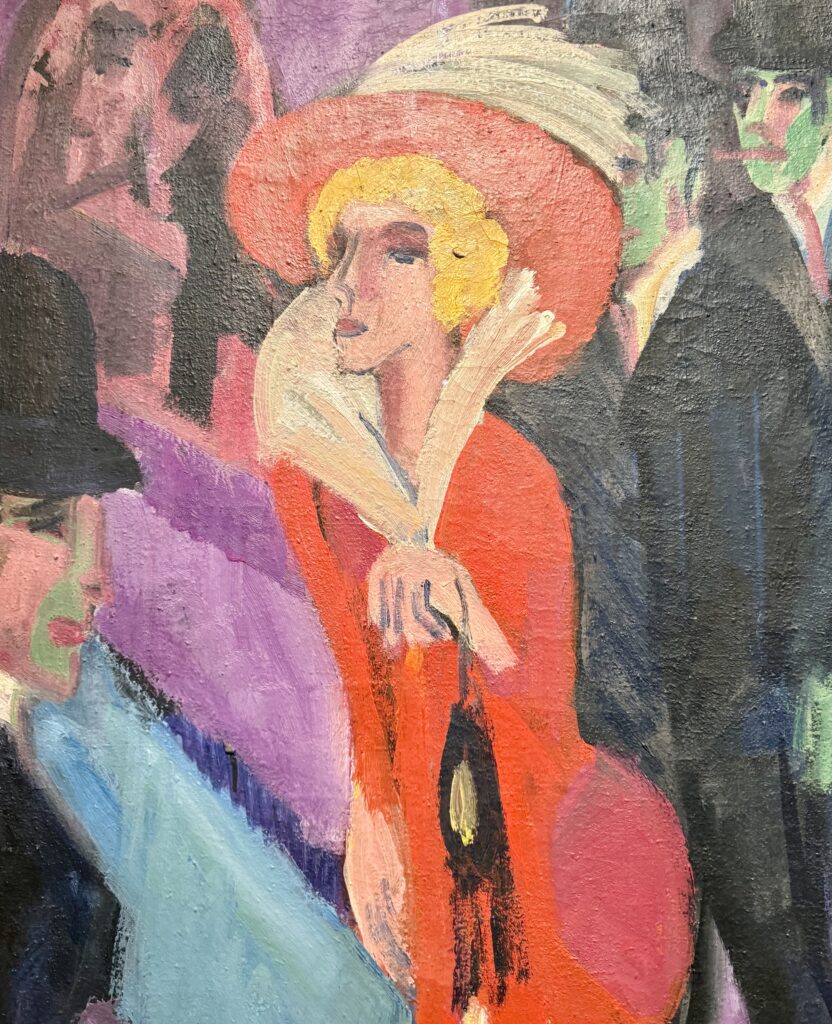
Some of these artists produced images with flat, simplified form, exaggerated facial features in setting with geometric decoration. They used unreal colors, to help achieve their maximalist aesthetic.
Others, like the Austrian artists Kokoschka and Schiele produced unsettling, almost disturbing images. They distorted the subjects’ visage to try to capture their inner psychological state.
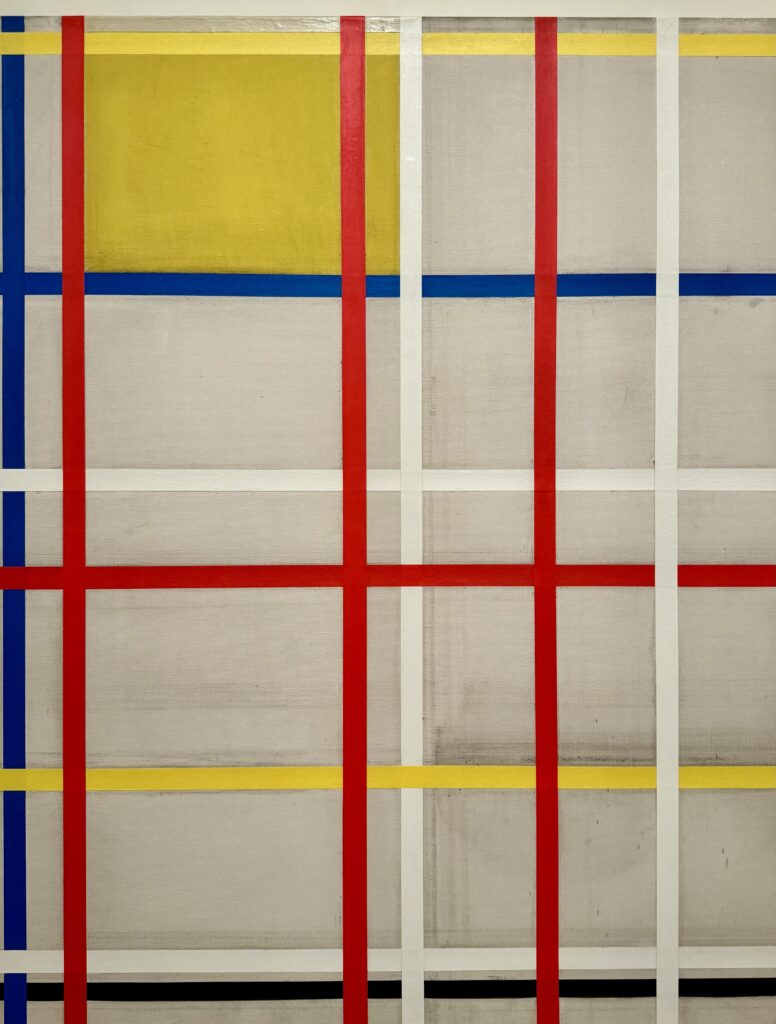
13. Minimalism
The Dutch artists Mondrian, Van Doesburg and Van der Leck laid the foundations of the Neo-plastic De Stijl group. They advocated an abstraction based on a utopian spirituality.
They sought to discover the immutable core of reality through geometric structure and primary colours.
Mondrian’s painting, in particular, evolved significantly due to the influence of Manhattan and American culture, along with his longstanding fascination with jazz music. Previously characterized by a certain rigidity, his artwork began to embody a new sense of freedom and vibrant rhythm.
The bustling energy of the great metropolis, with its grid-like layout and soaring skyscrapers — which Mondrian noted as being “the furthest from nature” — captured his imagination.
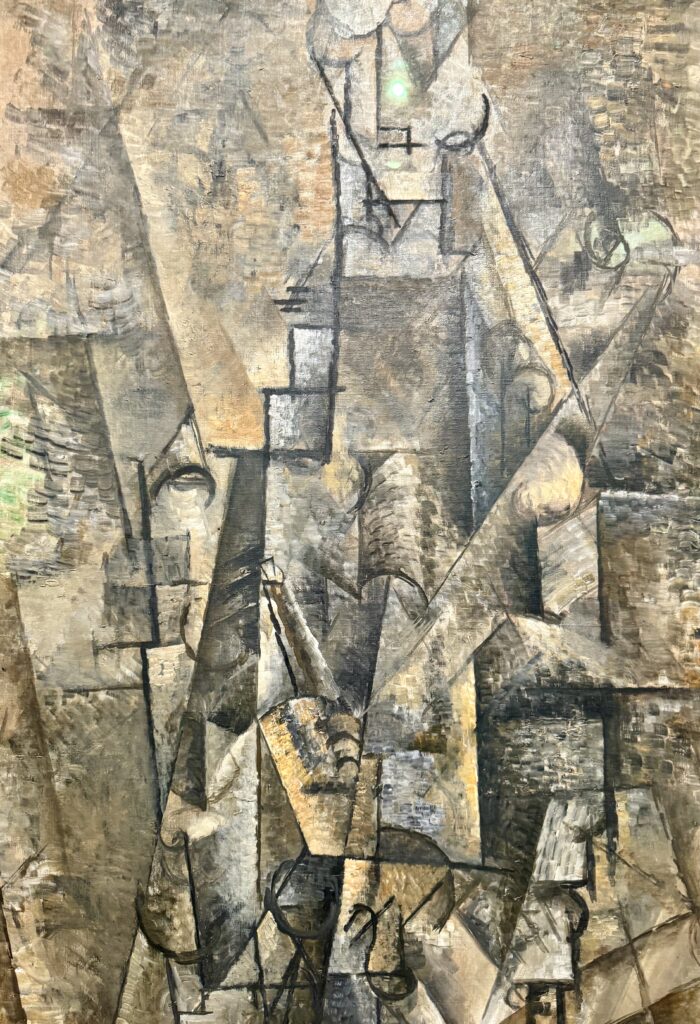
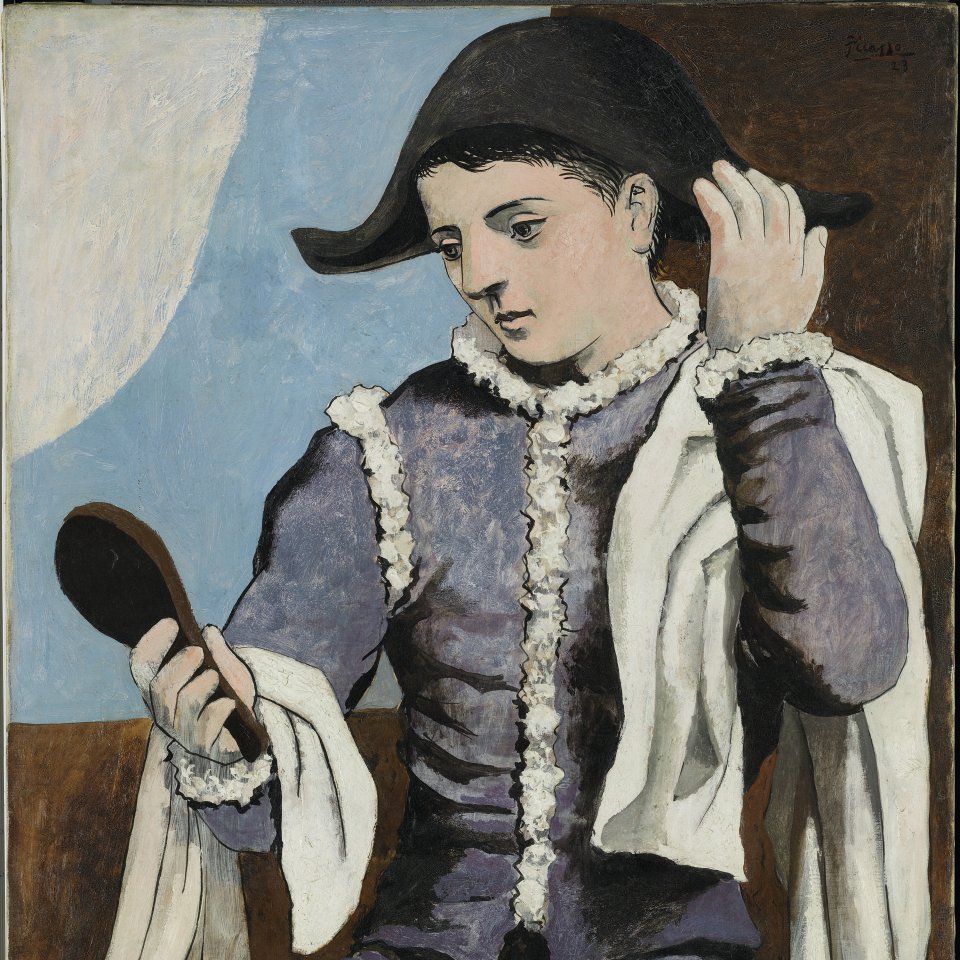
14. Picasso Paintings
The museum has quite a few Picasso paintings. Picasso is best known as the co-founder of Cubism.
That movement drew inspiration from the simplicity of Romanesque art, African masks, and Cézanne’s later works. It introduced a new way of viewing the world that shifted from naturalism to a constructed perception.
Man with a Clarinet is an example of the complex structures of Analytical Cubism. Cubism then evolved into a more straightforward style with flatter, recognizable shapes.
Later, during his “classical” period, Picasso painted Harlequin with a Mirror. Initially intended as a self-portrait, this painting combines three characters from the circus and the Commedia dell’arte that held a strong fascination for Picasso.
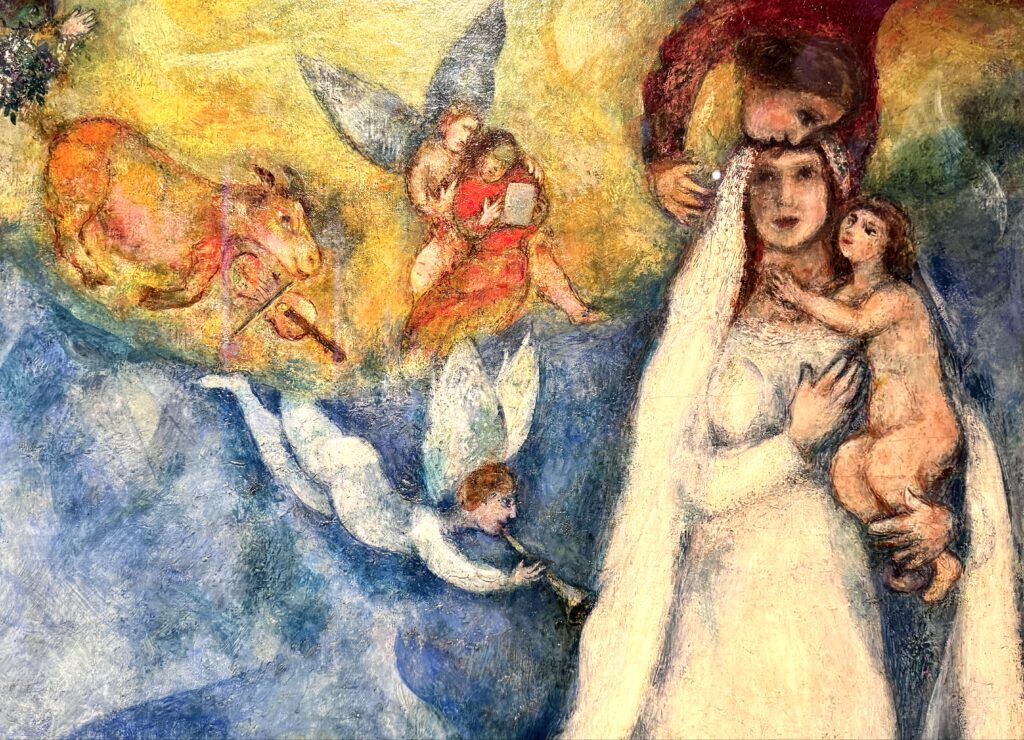
15. Chagall, The Madonna of the Village
Chagall was a Russian artist who moved to France from his hometown of Vitebsk in Belarus.
He created art that was vibrant and expressive, deeply rooted in the experiences of his life and the religious and cultural traditions of the Jewish community in Vitebsk.
His unique approach to painting combined modern artistic techniques with elements of fantasy from folklore and Russian stories. This positioned him as a pioneer in the Surrealist movement.
Chagall painted the Madonna when he was staying in Gordes, trying to avoid the Nazis. In a dream-like world, he depicts her holding a child in her arms, surrounded by angels singing and playing music. They’re accompanied by a flying cow with a violin.
The madonna is rendered on a monumental scale and wearing a bridal gown. She floats in a fantasy world that is so characteristic of the painter.
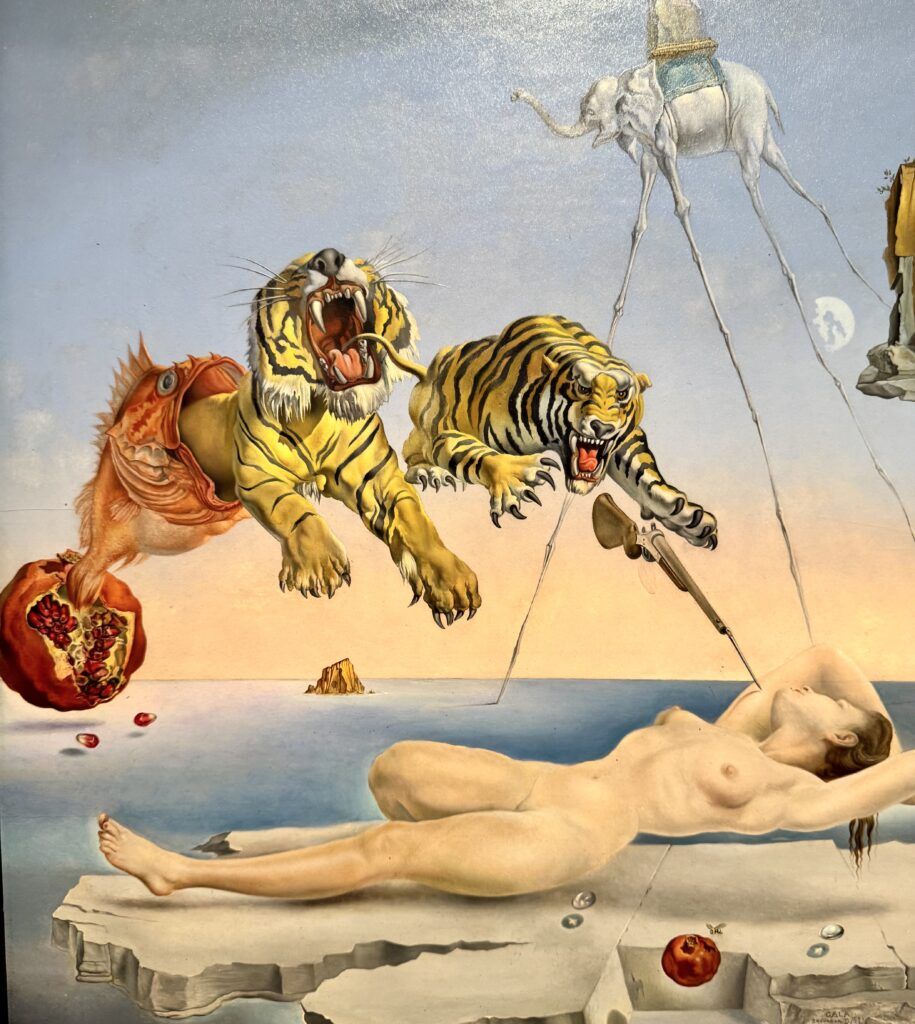
16. Dali, Dream
The museum is home to one of Dali’s most famous paintings (with an impossibly long name), Dream Caused by the Flight of a Bee around a Pomegranate a Second before Waking.
Salvador Dalí was a Spanish surrealist artist known for his striking and bizarre image. He blended dream-like elements with meticulous realism. The man could really draw!
Dalí fancied himself a Freudian painter of dreams, and he called his paintings “hand-painted dream photographs.”
In the Dream painting, you see the sleeping figure of Gala, Dalí’s wife and muse, floating above a rock in a watery landscape. In her dream, an exploding pomegranate shoots out a fish, from which two ferocious tigers emerge with a bayonet.
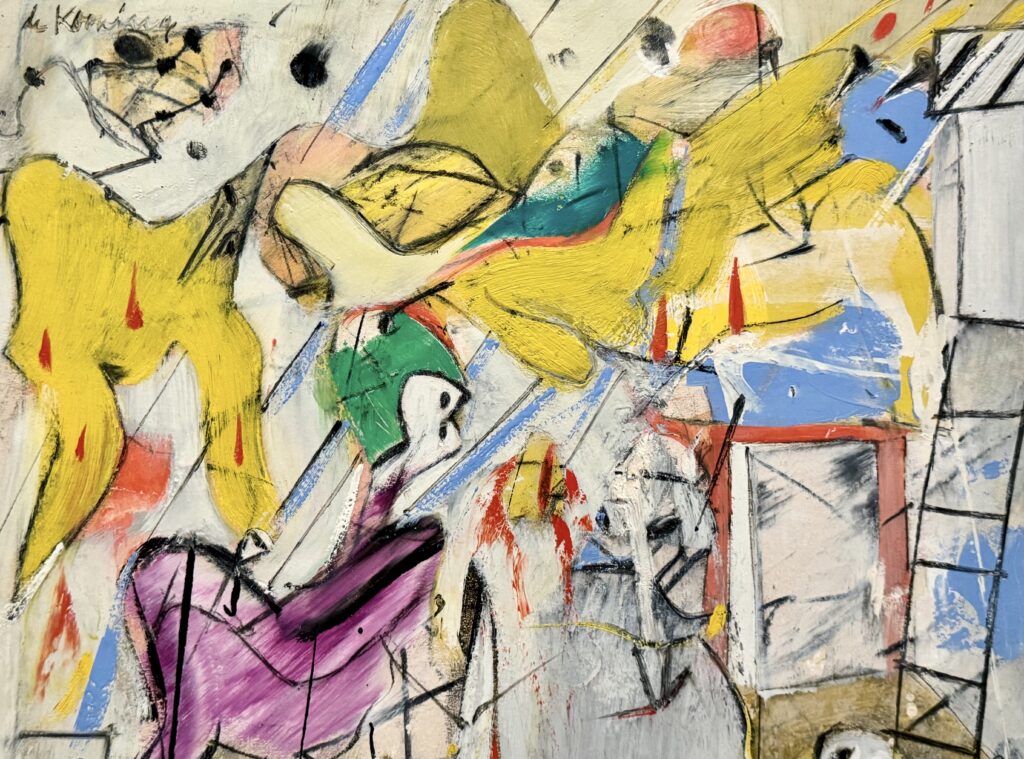
17. De Kooning, Abstraction
De Kooning was one of the founders of American Abstract Expressionism.
He was a Dutch-American artist who used bold brushstrokes and vibrant colors. He blended abstract forms with figuration, pushing the boundaries of modern painting.
De Kooning’s most famous pieces are his Woman paintings, which reflect his dynamic approach to form and composition. The museum has a couple pieces that pre-date Women.
In Abstraction, the artist introduced his groundbreaking approach to art, emphasizing gesture and color. Although titled Abstraction, the work incorporates classic visual themes and, like much of de Kooning’s oeuvre, is rich with figurative elements.
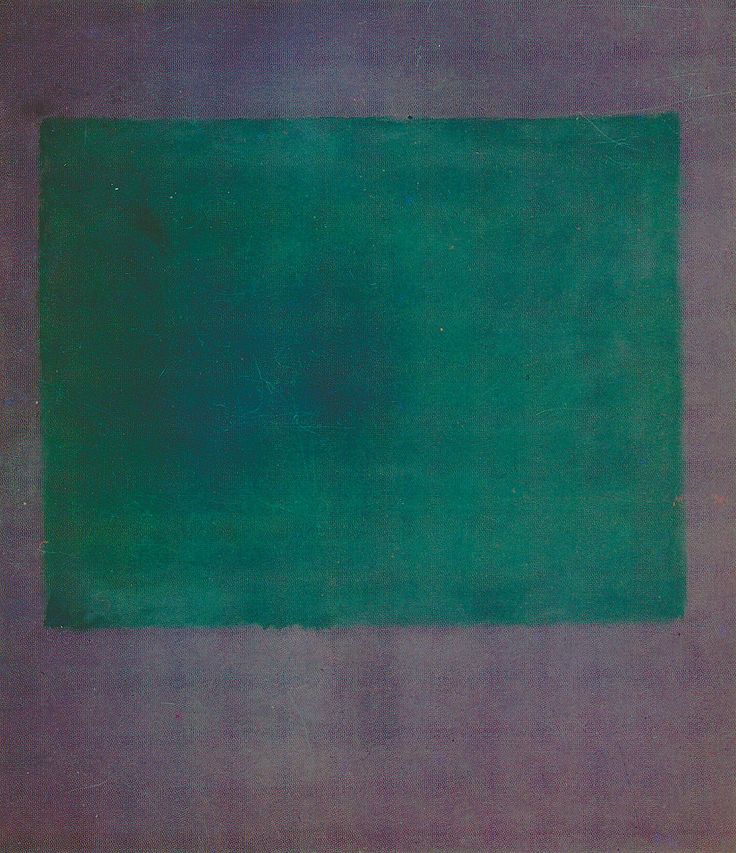
18. Rothko, Green on Maroon
Some of the leading figures of post-war American abstraction, like Mark Rothko, didn’t subscribe to the gestural style of Abstract Expressionism. Instead, they chose instead to develop geometrical languages.
Rothko is known for his painterly and evocative rectangles, which the artist said expressed “tragedy, ecstasy, and doom.”
In Green on Maroon, as was his wont, the painter arranged his painting into color fields of rectangular shapes that seem to float above an indeterminate space.
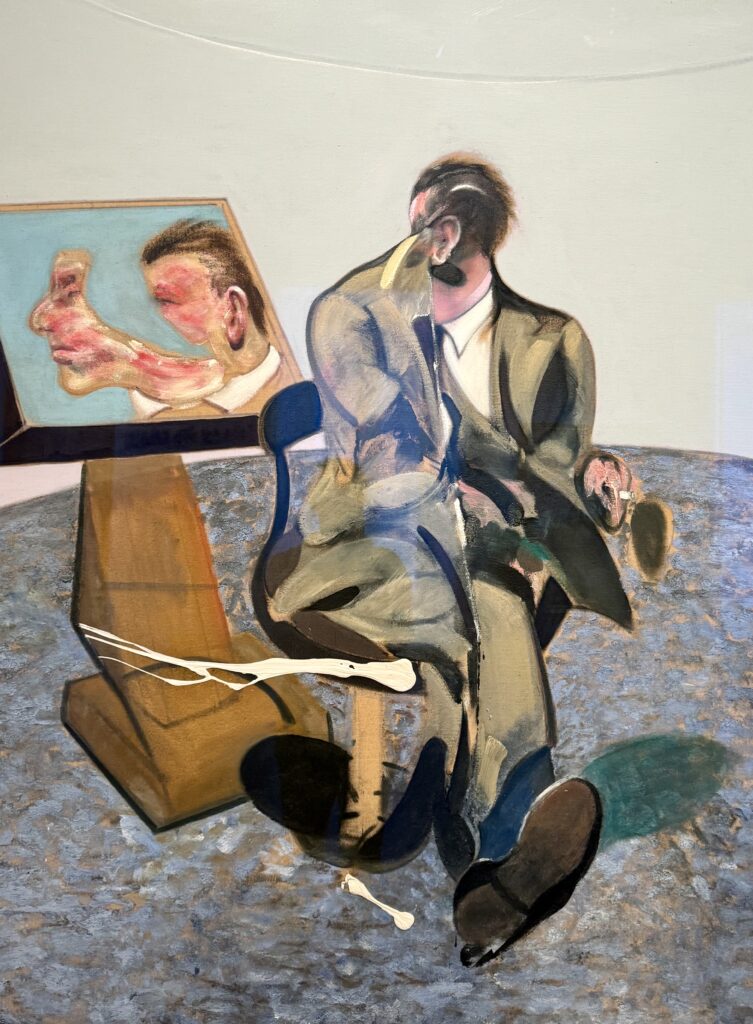
19. Francis Bacon, Portrait of George Dyer in a Mirror
Francis Bacon was a British painter known for his raw, unsettling imagery that delves deep into the human condition.
His emotionally charged and highly personal artworks often featuring distorted figures and faces. They explore themes of isolation, torment, and the complexities of the human psyche.
This painting is a double portrait of his lover of several years, George Dyer.
He its in a revolving chair facing a mirror placed on a strange piece of furniture with a stand. The image is violent, with its distorted body and spasm-twisted face.
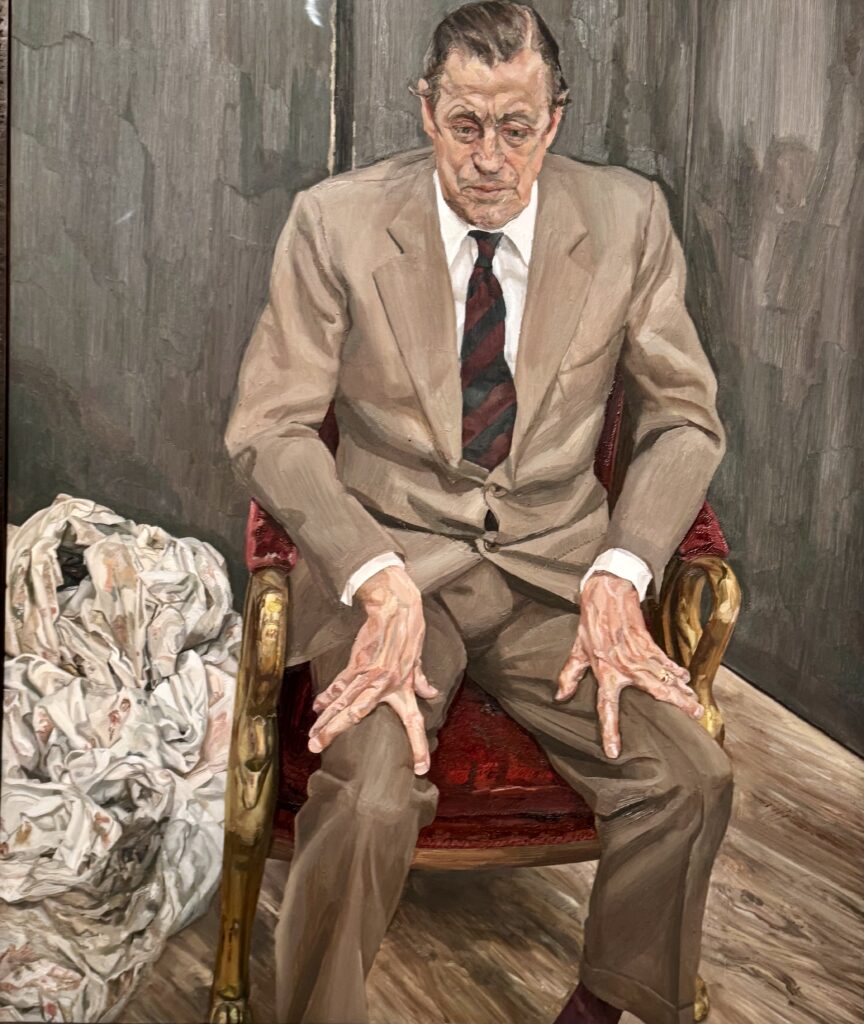
20. Lucien Freud, Man in a Chair
The grandson of psychoanalyst Sigmund Freud, Lucian Freud was one of the most outstanding figurative painters of the modern age.
With his family, he fled to Britain in 1933 to escape Nazi Germany.
Self-portraits, portraits, and nudes account for the bulk of his artistic production. He was known for capturing his subjects’ psychological depth and physical realism.
In this painting, he portrays the Brown Thyssen himself. In 1981, he paid his first visit to Freud’s London studio.
It was the first of myriad long, endless sittings for the portrait, which was finally completed in October 1982. The portrait shows both the intensity of the baron as well as the painter’s frenzied attempt to portray him.
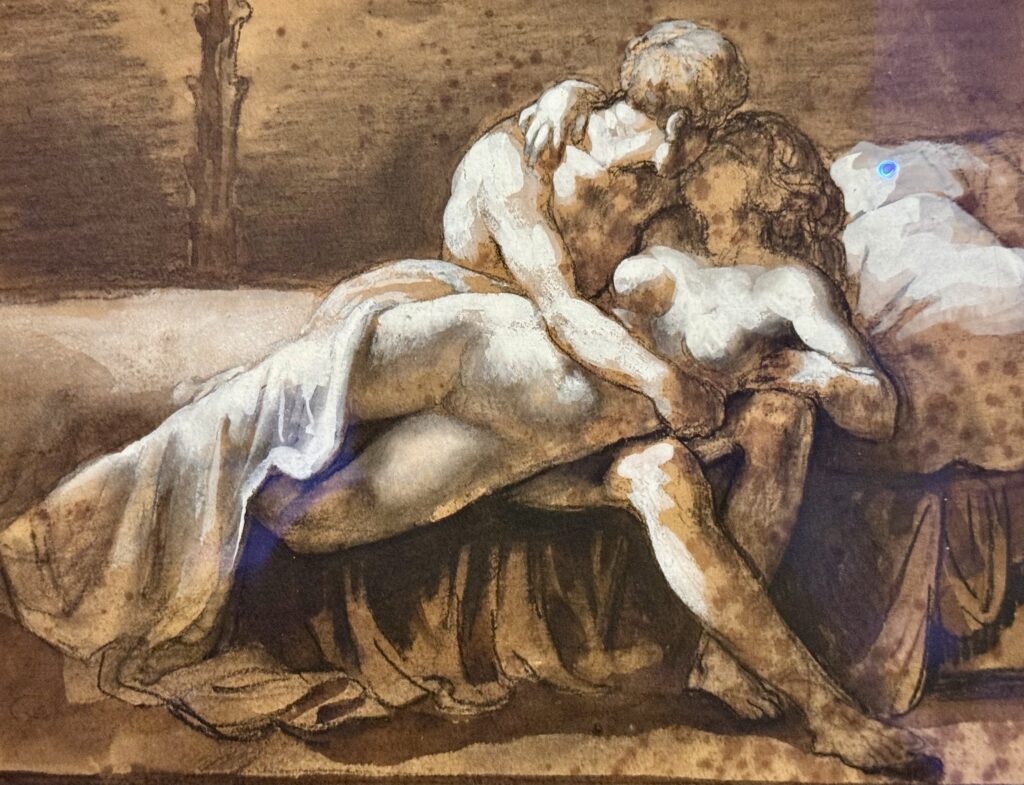
Practical Guide & Tips For The Thyssen- Bornemisza
Address: P.º del Prado, 8. The museum is right across from the Prado.
Hours: Monday: 1200 pm to 4:00 pm.Tuesday through Sunday from
10:00 am to 7:00 pm. The museum is free
Tickets: € 13.00. Click here to pre-book a skip the line ticket. You can also buy a combination ticket for the Thyssen, Reina Sofía, and the Prado.
Pro Tips:
You can check your bag or backpack for free. The museum has an absolutely wonderful gift shop with books, souvenirs, and a raft of artisan made wares.
You don’t really need an audio guide. There are explanatory panels for the major artistic movement. And you can scan QR codes for more information on individual paintings.
If you do get one, there are five thematic trails you can follow.
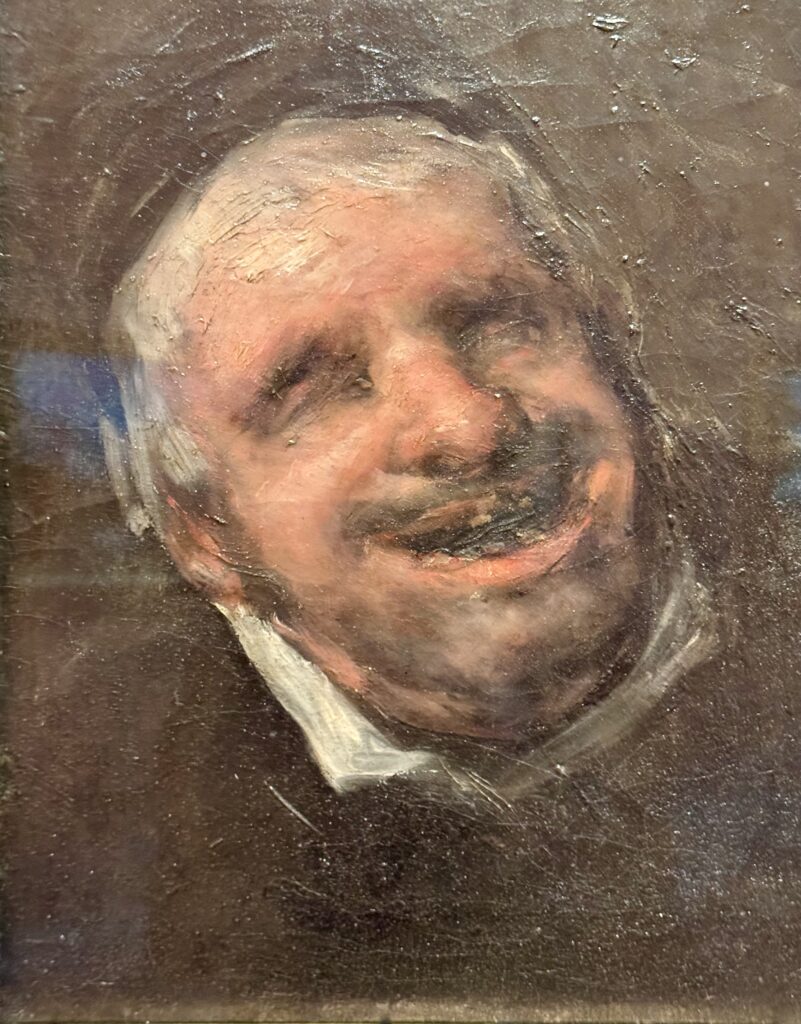
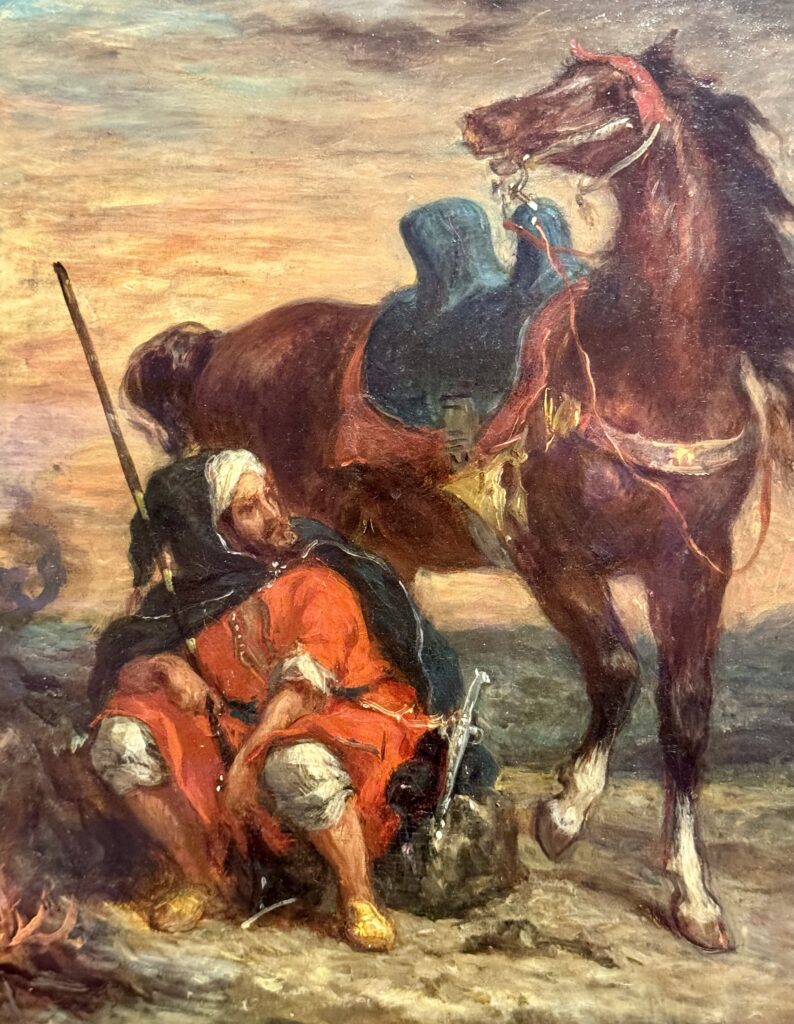
Unlike the Prado, you can take photos without a flash. But I found the lighting caused quite a bit of glare.
I hope you’ve enjoyed my guide to the Thyssen-Bornemisza. You may enjoy these other Spain travel guides and resources:
- 10 day itinerary for Andalusia
- Most Beautiful Towns in Andalusia
- 3 day itinerary for Seville
- 3 day itinerary for Barcelona
- 2 day Itinerary for Madrid
- 33 secret towns in Spain
- 10 day itinerary from Madrid to Seville
- 10 day itinerary from Barcelona to Bilbao
- 10 day itinerary for Basque Spain
- 2 day Itinerary for Bilbao
- 1 day in Toledo itinerary
Pin it for later.

